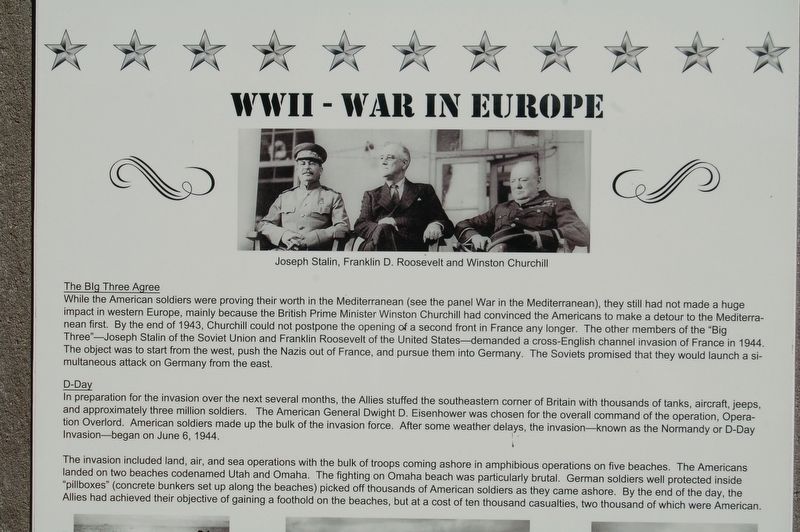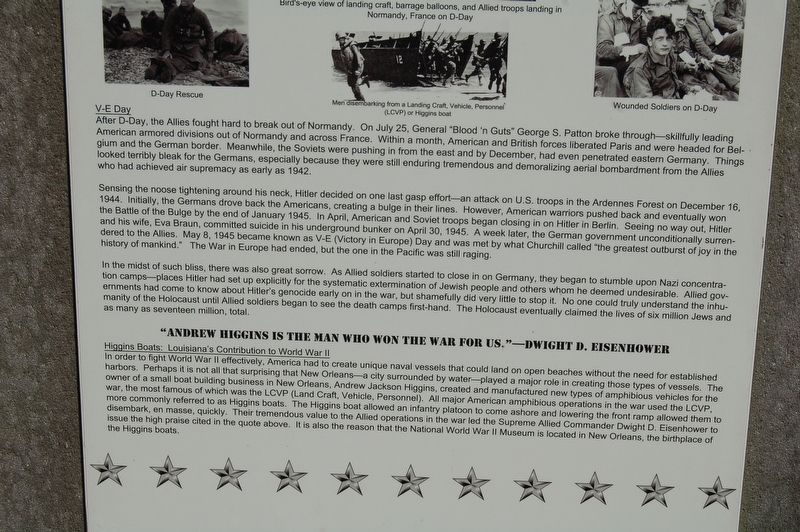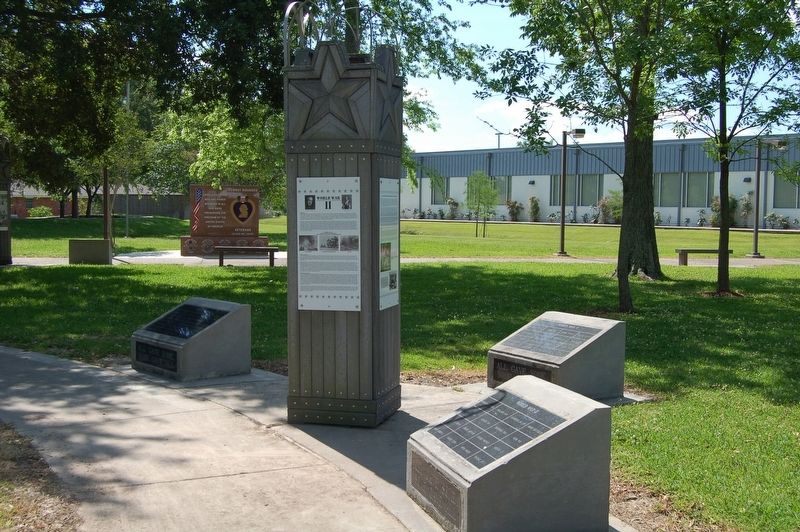WWII - War In Europe
The Big Three Agree
While the American soldiers were proving their worth in the Mediterranean (see the panel War in the Mediterranean), they still had not made a huge impact in western Europe, mainly because the British Prime Minister Winston Churchill had convinced the Americans to make a detour to the Mediterranean first. By the end of 1943, Churchill could not postpone the opening of a second front in France any longer. The other members of the “Big Three" —Joseph Stalin of the Soviet Union and Franklin Roosevelt of the United States—demanded a cross-English channel invasion of France in 1944. The object was to start from the west, push the Nazis out of France, and pursue them into Germany. The Soviets promised that they would launch a simultaneous attack on Germany from the east.
D-Day
In preparation for the invasion over the next several months, the Allies stuffed the southeastern corner of Britain with thousands of tanks, aircraft, jeeps, and approximately three million soldiers. The American General Dwight D. Eisenhower was chosen for the overall command of the operation, Operation Overlord. American soldiers made up the bulk of the invasion force. After some weather delays, the invasion—known as the Normandy or D-Day Invasion—began on June 6, 1944.
The invasion included
land, air, and sea operations with the bulk of troops coming ashore in amphibious operations on five beaches. The Americans landed on two beaches codenamed Utah and Omaha. The fighting on Omaha beach was particularly brutal. German soldiers well protected inside "pillboxes” (concrete bunkers set up along the beaches) picked off thousands of American soldiers as they came ashore. By the end of the day, the Allies had achieved their objective of gaining a foothold on the beaches, but at a cost of ten thousand casualties, two thousand of which were American. V-E Day
After D-Day, the Allies fought hard to break out of Normandy. On July 25, General “Blood 'n Guts” George S. Patton broke through—skillfully leading American armored divisions out of Normandy and across France. Within a month, American and British forces liberated Paris and were headed for Belgium and the German border. Meanwhile, the Soviets were pushing in from the east and by December, had even penetrated eastern Germany. Things looked terribly bleak for the Germans, especially because they were still enduring tremendous and demoralizing aerial bombardment from the Allies who had achieved air supremacy as early as 1942.
Sensing the noose tightening around his neck, Hitler decided on one last gasp effort—an attack on U.S. troops in the Ardennes Forest on December 16, 1944.
Initially, the Germans drove back the Americans, creating a bulge in their lines. However, American warriors pushed back and eventually won the Battle of the Bulge by the end of January 1945. In April, American and Soviet troops began closing in on Hitler in Berlin. Seeing no way out, Hitler and his wife, Eva Braun, committed suicide in his underground bunker on April 30, 1945. A week later, the German government unconditionally surrendered to the Allies. May 8, 1945 became known as V-E (Victory in Europe) Day and was met by what Churchill called “the greatest outburst of joy in the history of mankind." The War in Europe had ended, but the one in the Pacific was still raging.In the midst of such bliss, there was also great sorrow. As Allied soldiers started to close in on Germany, they began to stumble upon Nazi concentration camps-places Hitler had set up explicitly for the systematic extermination of Jewish people and others whom he deemed undesirable. Allied governments had come to know about Hitler's genocide early on in the war, but shamefully did very little to stop it. No one could truly understand the inhumanity of the Holocaust until Allied soldiers began to see the death camps first-hand. The Holocaust eventually claimed the lives of six million Jews and as many as seventeen million, total.
“ ANDREW HIGGINS IS THE MAN WHO WON THE WAR FOR US.”—DWIGHT D. EISENHOWER
Higgins Boats: Louisiana's Contribution to World War II
In order to fight World War Il effectively, America had to create unique naval vessels that could land on open beaches without the need for established harbors. Perhaps it is not all that surprising that New Orleans--a city surrounded by water-played a major role in creating those types of vessels. The Owner of a small boat building business in New Orleans, Andrew Jackson Higgins, created and manufactured new types of amphibious vehicles for the war, the most famous of which was the LCVP (Land Craft, Vehicle, Personnel). All major American amphibious operations in the war used the LCVP, more commonly referred to as Higgins boats. The Higgins boat allowed an infantry platoon to come ashore and lowering the front ramp allowed them to disembark, en masse, quickly. Their tremendous value to the Allied operations in the war led the Supreme Allied Commander Dwight D. Eisenhower to issue the high praise cited in the quote above. It is also the reason that the National World War II Museum is located in New Orleans, the birthplace of the Higgins boats.
Topics and series. This memorial is listed in this topic list: War, World II. In addition, it is included in the Former U.S. Presidents: #34 Dwight D. Eisenhower, and the The Holocaust series lists.
Location.
Other nearby markers. At least 8 other markers are within walking distance of this marker. WWII - War In The Mediterranean (here, next to this marker); World War II (here, next to this marker); WWII - War In The Pacific (here, next to this marker); A View From The Trenches: A Doughboy From Donaldsonville Writes Home (a few steps from this marker); World War I (a few steps from this marker); "The War to End War" (a few steps from this marker); The Vietnam War (a few steps from this marker); The Freedom Fountain (a few steps from this marker). Touch for a list and map of all markers in Gonzales.
More about this marker. Located at the Gonzales Veterans Memorial Park.
Credits. This page was last revised on April 1, 2018. It was originally submitted on April 1, 2018, by Cajun Scrambler of Assumption, Louisiana. This page has been viewed 217 times since then and 28 times this year. Photos: 1, 2, 3, 4. submitted on April 1, 2018.



